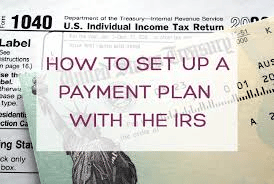 For the 2023 filing season, the IRS projects that some taxpayers will file and owe. Many will be able to pay, but a lot of them will need to make other arrangements because they can’t pay their full tax bills to the IRS.
For the 2023 filing season, the IRS projects that some taxpayers will file and owe. Many will be able to pay, but a lot of them will need to make other arrangements because they can’t pay their full tax bills to the IRS.
When taxpayers can’t pay their tax bills, they have a number of options, including payment plans, to pay off their Joe andoutstanding taxes and accrued penalties and interest. Of the 16 million taxpayers who owe back taxes, 97 percent of them qualify to use a payment plan that’s fairly easy to set up and would likely give them the best payment terms.
The IRS has three simplified payment plans:
- Guaranteed Installment Agreements (GIA):36-month payment terms for balances of $10,000 or less.
- Streamlined Installment Agreements (SLIA):72-month payment terms for balances of $50,000 or less.
- Streamlined Processing for Balances Between $50,000-$100,000:84-month payment terms for balances between $50,000 and $100,000.
Advantages of 36-, 72-, and 84-month agreements
These are the three most common IRS payment plans. They’re all easy to obtain from the IRS, because they:
- Require minimal, if any, financial disclosure to the IRS;
- Don’t require an IRS manager to approve the payment terms;
- Don’t require taxpayers to liquidate assets to pay the IRS; and,
- Can be set up in one phone call or interaction with the IRS.
The GIA (36 months) and SLIA (72 months) can be completed online using the Online Payment Agreement tool at IRS.gov. The GIA and SLIA are also attractive to taxpayers who don’t want a public record of their tax debt, because these agreements don’t require the IRS to file a public notice of federal tax lien. Taxpayers who owe between $25,000 and $50,000 must agree to pay by automated direct debit or payroll deductions to avoid a tax lien.
The “Streamlined Processing” 84-month payment plan works a little differently. The IRS started the 84-month plan as a pilot program in 2016 to make it easier for taxpayers who owe between $50,000 and $100,000 to get into a payment plan with the IRS. Taxpayers can avoid filing their financial information with the IRS if they agree to pay their tax bill by direct debit or payroll deductions. If they don’t agree to these automated payments, the IRS requires taxpayers to provide a Collection Information Statement (IRS Form 433-A or 433-F). Even with streamlined processing, the 84-month plan has one catch: The IRS will file a federal tax lien.
The pilot program for the 84-month plan is still in effect today. The IRS hasn’t completed its study on whether the 84-month plan is an effective collection option. One thing is clear about the program: It likely provides better payment terms and relieves burden for taxpayers.
The rules
GIAs are for taxpayers who owe the IRS $10,000 or less. As the name suggests, the payment plan is “guaranteed” if the taxpayer meets all conditions of the GIA:
- It’s for individual income taxes only;
- Total balances owed, including penalties and interest, must be $10,000 or less
- The taxpayer must pay within 36 months;
- All required tax returns have been filed; and,
- The taxpayer has not entered into an installment agreement in the previous five years.
SLIAs can be used by individual taxpayers who meet these conditions:
- It’s for income taxes and other assessments, including unpaid trust fund penalty assessments;
- The total assessedbalance is $50,000 or less (not including accruals of penalties and interest after the original assessment of tax, penalties, and interest);
- The taxpayer must pay within 72 months; and,
- All required tax returns have been filed.
Taxpayers can set a GIA or SLIA by:
- Using the online payment agreement tool at IRS.gov;
- Filing Form 9465 with the IRS; or,
- Contacting the IRS by phone
Terms may be shorter for old tax debt
Taxpayers should be aware that they may not get the full length of time to pay their outstanding tax balances if their debt is old. For each of these simple payment plan options, the IRS will limit the terms if the collection statute of limitations (generally 10 years from the date that tax is assessed) is shorter than the prescribed payment terms.
For example, if a taxpayer’s collection statute expires in 24 months, any GIA, SLIA, or 84-month plan will be limited to 24 months. Taxpayers who can’t afford these payments may have to consider a payment plan based on their ability to pay.
Ability-to-pay installment agreements require taxpayers to file a Collection Information Statement and prove their average monthly income and necessary living expenses. In addition, the IRS often asks taxpayers to liquidate or borrow against their assets to pay their outstanding tax bill in ability-to-pay agreements.
Fees apply
There is a setup fee for all IRS installment agreements. The fees range from $225 for installment agreements set up by phone and paid by check, to $31 for agreements set up online and paid by automatic direct debit. Taxpayers who meet low-income thresholds can get the fee waived.
Tips for all three agreements
The GIA, SLIA, and 84-month payment plans are usually the best way to set up a payment plan with the IRS. They’re usually quick and easy to set up and likely provide taxpayers with better payment terms than most other options.
Taxpayers who can’t pay according to the GIA and SLIA terms face tax liens if they owe more than $10,000. Taxpayers also need to request the GIA or SLIA before the IRS files a tax lien. After the lien is filed, taxpayers must pay their full balance to get the lien released, or pay down the balance to $25,000 to start lien-withdrawal proceedings.
Here are a few other tips related to these simple agreements:
- Avoid a tax lien – pay down the balance to get into a SLIA. Here’s the best plan for taxpayers who owe more than $50,000: Get an extension to pay of up to 120 days, get funds to pay the balance down to under $50,000, and obtain a SLIA. Doing so will avoid the filing of a tax lien.
- For SLIA, it’s the “assessed” balance – not the total amount owed. The $50,000 SLIA threshold is based on the taxpayer’s assessed balance– not the total amount they owe. The assessed balance includes tax, assessed penalties and interest, and all other assessments for each tax year. It doesn’t include accrued penalties and interest after the original assessment. For example, if a taxpayer’s original assessment is under $50,000 for an older tax year, he may accrue additional penalties and interest that puts the total balance over $50,000. In this situation, they would still qualify for a SLIA based on the original assessed balance. Taxpayers can also designate payments to reduce their “assessed balance only” to help them qualify for a SLIA.
- Apply and pay automatically to reduce fees.The IRS increases installment agreement setup fees if taxpayers pay by check. Reduce the setup fee by agreeing to automatic direct debit payments. Automatic payments also avoid a monthly reminder letter from the IRS about the payment due.
- Pay by direct debit or payroll deduction to avoid default. IRS installment agreements have a high default rate. To avoid a default, taxpayers must make their monthly payments. The best way to avoid missing a payment is to have the payment automatically deducted from the taxpayer’s financial accounts.
- Don’t owe again.The second most common cause of defaulted installment agreements is filing future tax returns with unpaid balances. Taxpayers need to change their withholding and/or make estimated tax payments to avoid owing taxes that they can’t pay in the future.
- Taxpayers can miss one payment a year. Most IRS payment plans allow taxpayers to miss one payment per year and not default. It’s best for the taxpayer to notify the IRS in advance if they can’t make a payment.
- If the taxpayer’s financial situation worsens, get an ability-to-pay plan. Taxpayers can always renegotiate their payment plans if their financial circumstances change. For example, if a taxpayer loses their job, they may not be able to pay the IRS. In these cases, the taxpayer can contact the IRS and provide documentation on their ability to pay. This may mean a lower payment or even payment deferral (called currently not collectible status). Be careful here: If the taxpayer owes more than $10,000 and can’t pay within 72 months, the IRS is likely to file a tax lien.
- Remember to ask for penalty abatement at the end of the plan. One important action to take at the end of a payment plan is to request abatement of the failure to pay penalty. Taxpayers should consider using first-time abatement or reasonable cause abatement if they qualify.
Each year, more than 3 million taxpayers get into a payment plan with the IRS. With tax reform, we can expect that more taxpayers will need a payment plan in 2019. Taxpayers who owe less than $100,000 should first look at 36-, 72-, or 84-month payment plans with the IRS. Many will also benefit from the help of a qualified tax professional to find the best option.
Need Help with an Installment Payment Plan?
Contact the Tax Lawyers at
Marini& Associates, P.A.
for a FREE Tax HELP Contact Us at:
www.TaxAid.com or www.OVDPLaw.com
or Toll Free at 888-8TaxAid (888) 882-9243
Read more at: Tax Times blog



